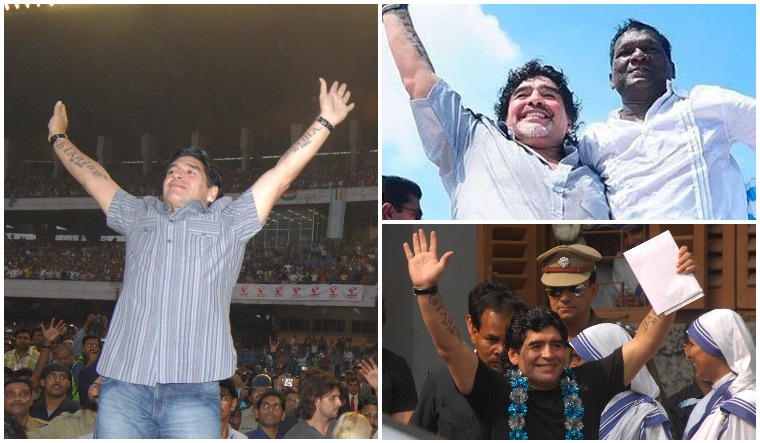An emotional people. That is what elevates a man from sporting legend to god. Polite applause at Lord’s did not a Tendulkar make. It was the collective “Aila!” of every shadow-batting kid on an Indian street that plucked the Mumbai boy from Shivaji Park and installed him at the head of the table of the nation’s sporting pantheon.
A long piece of land in Latin America knows this, too. For Argentina had, years before India started venerating Sachin, found its god in another five-foot-five, curly-haired frame.
The nation may take its name from Argentum, or more commonly silver, but it birthed and bred pure gold in Diego Maradona. Gold that shone across seas, and whose deft dance on the pitch raised goosebumps in faraway lands.
Kolkata was one such land.
And it was Kolkata that he chose for his Indian debut. The year was 2008 and the communists were still ruling West Bengal. Maradona was there to inaugurate a private football academy, but no one cared about that. There was to be an exhibition match at the Salt Lake Stadium in the heart of the city. As journalist Subhankar Mondal wrote for Goal.com then: “There was emotion when at the start of the match Maradona ran onto the pitch and did his famous juggling. There was emotion when during half-time some ball-boys rushed onto Maradona to touch him. Even the players who were participating in the exhibition match couldn’t resist feeling the emotions and feeling proud at being able to hug the Great Diego.”
The legend returned to India four years later, this time landing in another football-crazy state—Kerala. In fact, he celebrated his 52nd birthday in advance there, cutting a huge cake, dancing, trading headers with Indian legend I.M. Vijayan and kicking balls into the large crowd from a makeshift stage. Only emotion could explain it.
And though he had arrived with a capitalist aim (he was there to open a jewellery showroom), the state’s Marxists queued up to catch a glimpse of the fellow Che Guevara fan in their bastion of Kannur.
The jeweller, his host, also got him to wear a chatta and mundu (a traditional half-sleeved shirt and white dhoti). Their friendship later launched a thousand memes in Kerala, but none of them spiteful.
The next time India saw Maradona on its soil was in 2017, once again in Kolkata. A charity event was the reason, as if Indian fans needed one. There was another pull. Former cricket captain and future BCCI president Sourav Ganguly would be playing Maradona in an exhibition match. Sadly, the ageing icon didn’t last long on the pitch, but did kick off proceedings and exchange pleasantries with Ganguly.
Sure, Maradona was a shell of his former self, but those fervent Bengali eyes saw no belly, no out-of-breath senior and no misstep. This was a legend in the flesh, and they had got their pound.
His visits aside, Maradona had another connection with India. In his 2019 documentary, Indian-origin British filmmaker Asif Kapadia made Maradona his subject. Titled Diego Maradona, the 130-minute film was culled and put together from more than 500 hours of footage, a lot of which even Maradona was not privy to. In a telling moment in the film, he says, “When you're on the field, life goes away, the problems go away, everything goes away!”
Hopefully, God has curated a pitch for his genius child.
During his 2008 trip, Maradona expressed surprise at the frenzy he saw. “I didn’t know people loved soccer so much in this part of the world,” he said.
If only you had more time to find out, Diego.







